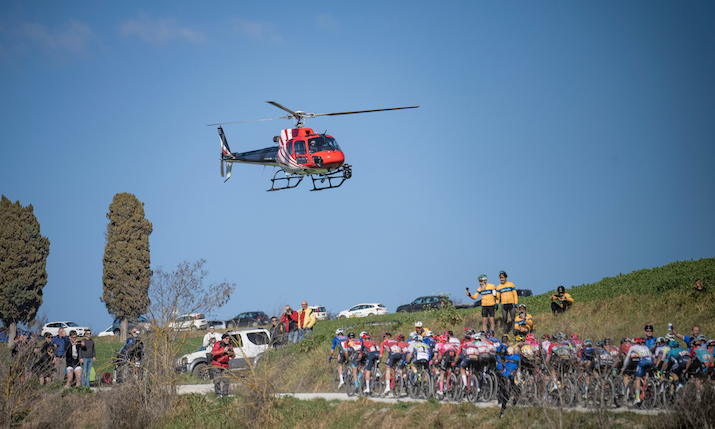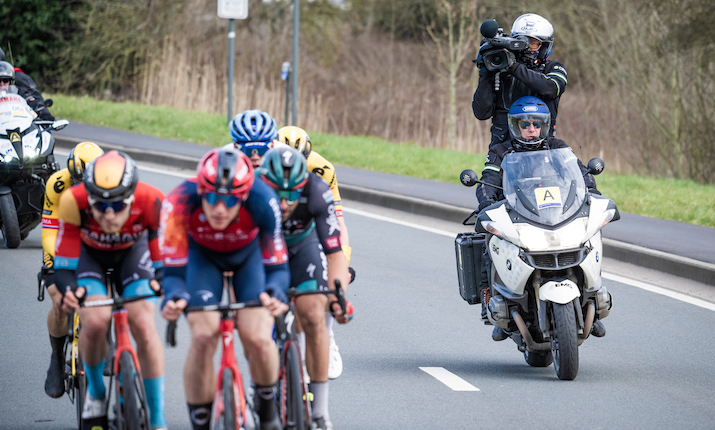Inside EMG’s technical set up for the 2023 UCI World Tour in Italy

Helicopters were used to capture the action of each race
Pictures: kramon
RCS Sport and EMG Italy recently produced a series of UCI World Tour spring cycling races in Italy, which were the classic Strade Bianche, the Tirreno-Adriatico – known as the Corsa dei Due Mari – the Milan-Turin and the Milan-San Remo.
In a previous article we described many of the innovations introduced at this year’s edition; however, two important features still remain to be explored, the graphics and the heavy deployment of technical structures dedicated to radio frequency connections.
Davide Furlan, outdoor production director at EMG Italy, has the details: “An important production innovation compared to the other editions concerns the live graphics and time tracking service, which is fully managed by the graphics division of EMG Boost Graphics, in partnership with Microplus for the time keeping.
“In addition to the management of international live graphics and a second line of graphics in Italian for RAI, this service include a GPS system for the continuous mapping of everything that moves on the ground and in the air with a view of the kilometres upon arrival and the gaps, the data processing for the official classifications and, thanks to various detectors along the route, the official timing of the road stages and the time trial stages.”
Furlan continues: “In EMG Italy, RCS has found a reliable partner mainly focused on improving the product and with the ability to manage the entire production chain, logistics control and production management in full collaboration with the RCS team.”
It was a truly European affair for EMG Group, with teams from Belgium, France and the Netherlands taking care of the radio frequency coverage of the route; EMG Connectivity with its Flemish crews covered the Strade Bianche and Tirreno-Adriatico events, after which the French team took over for the Milan-Turin and the demanding Milan-San Remo.
To achieve this extensive coverage, cyclists were followed by five HB motorcycles along the entire race route. Camera operators were equipped with UHD cameras which have been adapted by the EMG engineering department to be more ergonomically and technically usable for the complex work of the operator on board the motorcycle.
Another five bikes followed the athletes and were set up for unilateral live integrations for RAI Sport, RAI Radio and Eurosport.

Specially adapted UHD cameras were used by operators on motorbikes
The set up of the radio frequency connections was complex. EMG relied on equipment from LiveTools, a specialised department of EMG Group which, through the design and implementation of audio/video/data coding, managed all the reception, transmission and bidirectional remote control needs of each individual device running.
To achieve this, each filming device, whether on wheels or in flight, sent a signal to a pressurised aircraft which was equipped with numerous self-pointing receiving antennas under the belly and a transmitting antenna, also self-tracking, that can be extracted in flight and that extends to a distance of about two metres from the tail.
Inside the aircraft was an operations centre with two engineering technicians in control. The plane constantly performed an overflight at an altitude of 6/6.5km moving in circles, and receiving and transmitting every video, audio, and intercom signal plus data for colourimetry, iris and tally of motorcycles and helicopters, the real core of the production.
EMG also had a backup system in case of emergencies. Each vehicle moving along the route was equipped with 4G devices active in parallel with the RF systems, to guarantee maximum continuity of the live event.
The airborne section also included two helicopters for specialised filming with Cineflex equipment on board, which sent RF signals to the aircraft at high altitudes.
The intermediate positions
“The set up of the radio connections,” continues Furlan, “is complex because, given the considerable distances involved in each test – over 150 kilometres – and the potential difficulties due to atmospheric phenomena, the aircraft at high altitude would not be able to connect with the TV compound upon arrival. Therefore, some intermediate RF reception and retransmission stations based on a mobile control unit and a group SNG connection unit equipped with Mux and codecs were needed to be able to transmit all the RF signals received from the aircraft via satellite.
“The signals processed on board the aircraft are sent back to these intermediate means, placed halfway through, which receive all the ASI streams with NS4 encoding.”
From here, still packaged with NS4 technology, they are delivered to the on-site SNG unit which in turn sends two 12MB H265 bundles via satellite until arrival.
Here another SNG unit receives the signals downlink, unpacks them, decodes them into HD-SDI and passes them on to the control room which takes care of the final packaging, adding graphics and broadcasting the content.
Data signals were also emitted from the control room in the opposite direction, towards the aircraft and to the motorbikes: they included intercom and tally signals towards the camera operators.
Two aircraft were used for the Milan-Turin route, due to the mountainous terrain and the fact that the race lasted for more than six hours, and therefore exceeds the autonomy of a single aircraft.
“It is no small matter to be able to have two twin relay aircraft available, this is another strength of the EMG Group to guarantee service for the partner/customer,” concludes Furlan.
